#difference between ai and data science
Explore tagged Tumblr posts
Text
Complete Excel, AI and Data Science mega bundle.
Unlock Your Full Potential with Our 100-Hour Masterclass: The Ultimate Guide to Excel, Python, and AI.
Why Choose This Course? In today’s competitive job market, mastering a range of technical skills is more important than ever. Our 100-hour comprehensive course is designed to equip you with in-demand capabilities in Excel, Python, and Artificial Intelligence (AI), providing you with the toolkit you need to excel in the digital age.
To read more click here <<
Become an Excel Pro Delve deep into the intricacies of Excel functions, formulae, and data visualization techniques. Whether you’re dealing with basic tasks or complex financial models, this course will make you an Excel wizard capable of tackling any challenge.
Automate Your Workflow with Python Scripting in Python doesn’t just mean writing code; it means reclaiming your time. Automate everyday tasks, interact with software applications, and boost your productivity exponentially.
If you want to get full course click here <<
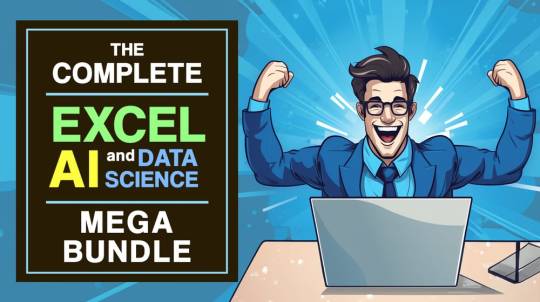
Turn Ideas into Apps Discover the potential of Amazon Honeycode to create custom apps tailored to your needs. Whether it’s for data management, content tracking, or inventory — transform your creative concepts into practical solutions.
Be Your Own Financial Analyst Unlock the financial functionalities of Excel to manage and analyze business data. Create Profit and Loss statements, balance sheets, and conduct forecasting with ease, equipping you to make data-driven decisions.
Embark on an AI Journey Step into the future with AI and machine learning. Learn to build advanced models, understand neural networks, and employ TensorFlow. Turn big data into actionable insights and predictive models.
Master Stock Prediction Gain an edge in the market by leveraging machine learning for stock prediction. Learn to spot trends, uncover hidden patterns, and make smarter investment decisions.
Who Is This Course For? Whether you’re a complete beginner or a seasoned professional looking to upskill, this course offers a broad and deep understanding of Excel, Python, and AI, preparing you for an ever-changing work environment.
Invest in Your Future This isn’t just a course; it’s a game-changer for your career. Enroll now and set yourself on a path to technological mastery and unparalleled career growth.
Don’t Wait, Transform Your Career Today! Click here to get full course <<

#data science#complete excel course#excel#data science and machine learning#microsoft excel#difference between ai and data science#learn excel#complete microsoft excel tutorial#difference between data science and data engineering#365 data science#aegis school of data science#advanced excel#excel tips and tricks#advanced excel full course#computer science#ms in data science#pgp in data science#python data science#python data science tutorial#Tumblr
1 note
·
View note
Text
This article highlights the key difference between Machine Learning and Artificial Intelligence based on approach, learning, application, output, complexity, etc.
#Difference between AI and ML#ai vs ml#artificial intelligence vs machine learning#key differences between ai and ml#artificial intelligence#machine learning#AI#ML#technology#data science#automation#robotics#neural networks#deep learning#natural language processing#computer vision#predictive analytics#big data#future trends.
2 notes
·
View notes
Text
Bubble findings could unlock better electrode and electrolyzer designs
New Post has been published on https://thedigitalinsider.com/bubble-findings-could-unlock-better-electrode-and-electrolyzer-designs/
Bubble findings could unlock better electrode and electrolyzer designs
Industrial electrochemical processes that use electrodes to produce fuels and chemical products are hampered by the formation of bubbles that block parts of the electrode surface, reducing the area available for the active reaction. Such blockage reduces the performance of the electrodes by anywhere from 10 to 25 percent.
But new research reveals a decades-long misunderstanding about the extent of that interference. The findings show exactly how the blocking effect works and could lead to new ways of designing electrode surfaces to minimize inefficiencies in these widely used electrochemical processes.
It has long been assumed that the entire area of the electrode shadowed by each bubble would be effectively inactivated. But it turns out that a much smaller area — roughly the area where the bubble actually contacts the surface — is blocked from its electrochemical activity. The new insights could lead directly to new ways of patterning the surfaces to minimize the contact area and improve overall efficiency.
The findings are reported today in the journal Nanoscale, in a paper by recent MIT graduate Jack Lake PhD ’23, graduate student Simon Rufer, professor of mechanical engineering Kripa Varanasi, research scientist Ben Blaiszik, and six others at the University of Chicago and Argonne National Laboratory. The team has made available an open-source, AI-based software tool that engineers and scientists can now use to automatically recognize and quantify bubbles formed on a given surface, as a first step toward controlling the electrode material’s properties.
Play video
Gas-evolving electrodes, often with catalytic surfaces that promote chemical reactions, are used in a wide variety of processes, including the production of “green” hydrogen without the use of fossil fuels, carbon-capture processes that can reduce greenhouse gas emissions, aluminum production, and the chlor-alkali process that is used to make widely used chemical products.
These are very widespread processes. The chlor-alkali process alone accounts for 2 percent of all U.S. electricity usage; aluminum production accounts for 3 percent of global electricity; and both carbon capture and hydrogen production are likely to grow rapidly in coming years as the world strives to meet greenhouse-gas reduction targets. So, the new findings could make a real difference, Varanasi says.
“Our work demonstrates that engineering the contact and growth of bubbles on electrodes can have dramatic effects” on how bubbles form and how they leave the surface, he says. “The knowledge that the area under bubbles can be significantly active ushers in a new set of design rules for high-performance electrodes to avoid the deleterious effects of bubbles.”
“The broader literature built over the last couple of decades has suggested that not only that small area of contact but the entire area under the bubble is passivated,” Rufer says. The new study reveals “a significant difference between the two models because it changes how you would develop and design an electrode to minimize these losses.”
To test and demonstrate the implications of this effect, the team produced different versions of electrode surfaces with patterns of dots that nucleated and trapped bubbles at different sizes and spacings. They were able to show that surfaces with widely spaced dots promoted large bubble sizes but only tiny areas of surface contact, which helped to make clear the difference between the expected and actual effects of bubble coverage.
Developing the software to detect and quantify bubble formation was necessary for the team’s analysis, Rufer explains. “We wanted to collect a lot of data and look at a lot of different electrodes and different reactions and different bubbles, and they all look slightly different,” he says. Creating a program that could deal with different materials and different lighting and reliably identify and track the bubbles was a tricky process, and machine learning was key to making it work, he says.
Using that tool, he says, they were able to collect “really significant amounts of data about the bubbles on a surface, where they are, how big they are, how fast they’re growing, all these different things.” The tool is now freely available for anyone to use via the GitHub repository.
By using that tool to correlate the visual measures of bubble formation and evolution with electrical measurements of the electrode’s performance, the researchers were able to disprove the accepted theory and to show that only the area of direct contact is affected. Videos further proved the point, revealing new bubbles actively evolving directly under parts of a larger bubble.
The researchers developed a very general methodology that can be applied to characterize and understand the impact of bubbles on any electrode or catalyst surface. They were able to quantify the bubble passivation effects in a new performance metric they call BECSA (Bubble-induced electrochemically active surface), as opposed to ECSA (electrochemically active surface area), that is used in the field. “The BECSA metric was a concept we defined in an earlier study but did not have an effective method to estimate until this work,” says Varanasi.
The knowledge that the area under bubbles can be significantly active ushers in a new set of design rules for high-performance electrodes. This means that electrode designers should seek to minimize bubble contact area rather than simply bubble coverage, which can be achieved by controlling the morphology and chemistry of the electrodes. Surfaces engineered to control bubbles can not only improve the overall efficiency of the processes and thus reduce energy use, they can also save on upfront materials costs. Many of these gas-evolving electrodes are coated with catalysts made of expensive metals like platinum or iridium, and the findings from this work can be used to engineer electrodes to reduce material wasted by reaction-blocking bubbles.
Varanasi says that “the insights from this work could inspire new electrode architectures that not only reduce the usage of precious materials, but also improve the overall electrolyzer performance,” both of which would provide large-scale environmental benefits.
The research team included Jim James, Nathan Pruyne, Aristana Scourtas, Marcus Schwarting, Aadit Ambalkar, Ian Foster, and Ben Blaiszik at the University of Chicago and Argonne National Laboratory. The work was supported by the U.S. Department of Energy under the ARPA-E program.
#Accounts#ai#aluminum#Analysis#bubbles#Capture#carbon#carbon capture#catalyst#catalysts#chemical#chemical reactions#chemicals#chemistry#Cleaner industry#climate change#Computer science and technology#contacts#data#deal#Department of Energy (DoE)#Design#designers#Difference Between#effects#efficiency#electricity#electrochemical#electrode#electrodes
0 notes
Text

weird/uncommon genres | dr ideas

date: december 16, 2024

Im never making a joke again 😭 after talking to my friend abt it, i feel better, but im still too scared. I thought poop jokes were childish and funny, like “your mom” 😭 regardless, nobody's seeing a joke from me ever again unless it’s on tiktok-- just to be clear tho, even if I found it funny, if the other party didn't, obviously the fault relies on me
I saw a guy get canceled for saying “your mom” too— though tbf it’s bc in Confucian countries it’s really bad to joke about your parents
sjfhdhsks I wanna cry…
Anyway, I haven't done these in awhile; I'm not sure if yall like my aethergarde academy posts more, these kinds of posts, or both (equally).
it's been awhile-- here's some weird ass genres you could make a DR from.
disclaimer: I used chatgpt (out of curiousity for some of these genres, those genres are made up and are not actual terms. Italicized ideas are ones from chatGPT. Guys it's unfair how good chatgpt is getting.. my brother told me that the goal of the current model is to have the AI simulate proper critical thinking instead of simply spitting out information.. isn't that crazy)

futuristic
cli-fi - this genre delves not only into climate change itself, but issues relating to the sun disappearing, or the world freezing. I remember seeing a shifter somewhere saying that she shifted here bc in her previous reality climate change was getting really really bad.
social sci-fi - focuses on how humans interact and behave in a futuristic setting.
planetary romance - exploration of different planets + romance, especially with an alien. Also characterized by distinctive extraterrestrial cultures and backgrounds.
data gothic - cyberpunk x gothic horror; characters encounter malevolent AI beings, digital ghosts, and corrupted data streams.
cosmic agriculture - genre focused on growing plant life in outer space or on different planets. Can also including breeding alien organisms (bacteria).
psychic noir - solve crimes in a world where memories, emotions, and thoughts could be hacked, manipulated, or weaponized. I think I'd make the memory thing extremely hard to do, since if it was too common I think it'd cause way too much havoc.
eco-metamorphosis - kinda like alien stage, but if you'd like, it could be less dark. This genre centers around earth being colonized by aliens, but the goal isn't to reject these changes, but rather to coexist with the other species.
liminal
slipstream - "speculative fiction that blends together science fiction, fantasy, and literary fiction or does not remain in conventional boundaries of genre and narrative"
abandoned intentions - explore incomplete worlds-- as if the world was abandoned mid-creation.
fantasy
lost world - discovering a hidden civilization, like atlantis or lumeria.
subterranean - a world that is primarily in an underground setting; similar to the hollow earth theory.
mythic/mythopeia - "fiction that is rooted in, inspired by, or that in some way draws from the tropes, themes, and symbolism of myth, legend, folklore, and fairy tales."; very similar to my wandering apocathary dr.
oceanic
nautical fiction - relationship between humans and the sea; "human relationship to the sea and sea voyages and highlights nautical culture in these environment".
wholesome/cute
furry sleuth - this is not about furries-- this is essentially a mystery where the main character is a household animal, typically a dog. Said animal would be the detective and solve mysteries.
cashier memoir - this genre always takes place in the head of a cashier. The goal is to come across as many different kinds of people as possible. This would be incredibly boring in this reality, but imagine if you were a barista in a fantasy or futuristic reality... you'd come across a lot of people without much effort or mental strain.
epistolary - a story told exclusively through fictional letters, newspaper articles, emails, and even texts. This isn't necessarily a genre of DR, but I think it'd be really interesting to guess/assume the plot of a DR through short snippets of letters or texts.
#shiftblr#reality shifting#shifting community#lalalian#shifting blog#desired reality#shifters#shifting diary#shifttok#scripting#shifting ideas
175 notes
·
View notes
Text
The Coprophagic AI crisis

I'm on tour with my new, nationally bestselling novel The Bezzle! Catch me in TORONTO on Mar 22, then with LAURA POITRAS in NYC on Mar 24, then Anaheim, and more!

A key requirement for being a science fiction writer without losing your mind is the ability to distinguish between science fiction (futuristic thought experiments) and predictions. SF writers who lack this trait come to fancy themselves fortune-tellers who SEE! THE! FUTURE!
The thing is, sf writers cheat. We palm cards in order to set up pulp adventure stories that let us indulge our thought experiments. These palmed cards – say, faster-than-light drives or time-machines – are narrative devices, not scientifically grounded proposals.
Historically, the fact that some people – both writers and readers – couldn't tell the difference wasn't all that important, because people who fell prey to the sf-as-prophecy delusion didn't have the power to re-orient our society around their mistaken beliefs. But with the rise and rise of sf-obsessed tech billionaires who keep trying to invent the torment nexus, sf writers are starting to be more vocal about distinguishing between our made-up funny stories and predictions (AKA "cyberpunk is a warning, not a suggestion"):
https://www.antipope.org/charlie/blog-static/2023/11/dont-create-the-torment-nexus.html
In that spirit, I'd like to point to how one of sf's most frequently palmed cards has become a commonplace of the AI crowd. That sleight of hand is: "add enough compute and the computer will wake up." This is a shopworn cliche of sf, the idea that once a computer matches the human brain for "complexity" or "power" (or some other simple-seeming but profoundly nebulous metric), the computer will become conscious. Think of "Mike" in Heinlein's *The Moon Is a Harsh Mistress":
https://en.wikipedia.org/wiki/The_Moon_Is_a_Harsh_Mistress#Plot
For people inflating the current AI hype bubble, this idea that making the AI "more powerful" will correct its defects is key. Whenever an AI "hallucinates" in a way that seems to disqualify it from the high-value applications that justify the torrent of investment in the field, boosters say, "Sure, the AI isn't good enough…yet. But once we shovel an order of magnitude more training data into the hopper, we'll solve that, because (as everyone knows) making the computer 'more powerful' solves the AI problem":
https://locusmag.com/2023/12/commentary-cory-doctorow-what-kind-of-bubble-is-ai/
As the lawyers say, this "cites facts not in evidence." But let's stipulate that it's true for a moment. If all we need to make the AI better is more training data, is that something we can count on? Consider the problem of "botshit," Andre Spicer and co's very useful coinage describing "inaccurate or fabricated content" shat out at scale by AIs:
https://papers.ssrn.com/sol3/papers.cfm?abstract_id=4678265
"Botshit" was coined last December, but the internet is already drowning in it. Desperate people, confronted with an economy modeled on a high-speed game of musical chairs in which the opportunities for a decent livelihood grow ever scarcer, are being scammed into generating mountains of botshit in the hopes of securing the elusive "passive income":
https://pluralistic.net/2024/01/15/passive-income-brainworms/#four-hour-work-week
Botshit can be produced at a scale and velocity that beggars the imagination. Consider that Amazon has had to cap the number of self-published "books" an author can submit to a mere three books per day:
https://www.theguardian.com/books/2023/sep/20/amazon-restricts-authors-from-self-publishing-more-than-three-books-a-day-after-ai-concerns
As the web becomes an anaerobic lagoon for botshit, the quantum of human-generated "content" in any internet core sample is dwindling to homeopathic levels. Even sources considered to be nominally high-quality, from Cnet articles to legal briefs, are contaminated with botshit:
https://theconversation.com/ai-is-creating-fake-legal-cases-and-making-its-way-into-real-courtrooms-with-disastrous-results-225080
Ironically, AI companies are setting themselves up for this problem. Google and Microsoft's full-court press for "AI powered search" imagines a future for the web in which search-engines stop returning links to web-pages, and instead summarize their content. The question is, why the fuck would anyone write the web if the only "person" who can find what they write is an AI's crawler, which ingests the writing for its own training, but has no interest in steering readers to see what you've written? If AI search ever becomes a thing, the open web will become an AI CAFO and search crawlers will increasingly end up imbibing the contents of its manure lagoon.
This problem has been a long time coming. Just over a year ago, Jathan Sadowski coined the term "Habsburg AI" to describe a model trained on the output of another model:
https://twitter.com/jathansadowski/status/1625245803211272194
There's a certain intuitive case for this being a bad idea, akin to feeding cows a slurry made of the diseased brains of other cows:
https://www.cdc.gov/prions/bse/index.html
But "The Curse of Recursion: Training on Generated Data Makes Models Forget," a recent paper, goes beyond the ick factor of AI that is fed on botshit and delves into the mathematical consequences of AI coprophagia:
https://arxiv.org/abs/2305.17493
Co-author Ross Anderson summarizes the finding neatly: "using model-generated content in training causes irreversible defects":
https://www.lightbluetouchpaper.org/2023/06/06/will-gpt-models-choke-on-their-own-exhaust/
Which is all to say: even if you accept the mystical proposition that more training data "solves" the AI problems that constitute total unsuitability for high-value applications that justify the trillions in valuation analysts are touting, that training data is going to be ever-more elusive.
What's more, while the proposition that "more training data will linearly improve the quality of AI predictions" is a mere article of faith, "training an AI on the output of another AI makes it exponentially worse" is a matter of fact.

Name your price for 18 of my DRM-free ebooks and support the Electronic Frontier Foundation with the Humble Cory Doctorow Bundle.

If you'd like an essay-formatted version of this post to read or share, here's a link to it on pluralistic.net, my surveillance-free, ad-free, tracker-free blog:
https://pluralistic.net/2024/03/14/14/inhuman-centipede#enshittibottification

Image: Plamenart (modified) https://commons.wikimedia.org/wiki/File:Double_Mobius_Strip.JPG
CC BY-SA 4.0 https://creativecommons.org/licenses/by-sa/4.0/deed.en
#pluralistic#ai#generative ai#André Spicer#botshit#habsburg ai#jathan sadowski#ross anderson#inhuman centipede#science fiction#mysticism
555 notes
·
View notes
Note
How did you discover your kintypes?
Good question!
Short answer: I didn't, you can't, (math analogy)
Long answer:
I don't believe one can ever actually "discover" their kintypes, because that's one of those concepts that you can have puzzled out down to the most minute detail and still not be able to touch the pure truth. It's too subjective. It's like science. The most you can do is go with the closest theory you have, and that's what you tell people, and if there are no glitsches then it's as close to right as you can come, but the relationship I have with the certainty of my kintypes is asymptotic.
I know what you're asking though is how I landed on the ones I've named, but idk, it's kind of different between them, and they all have to come with the background understanding that they might just straight up change. I'm an osprey from dedicated and extensive research, comparing behavioral and anatomical data points, and deciding on the most exact conclusion that also makes me comfortable. I'm an alien because over several years I slowly and gradually had the creeping realization that I wouldn't have ever been anything else still knowing I'm alterhuman, but I'm a novakid specifically because I found them on a fan wiki for homebrew D&D races and was up until 6 am frantically having (literal) lights go off in my head and then less than a few hours after I first heard of Starbound, I was one. I know the robot bug and audiophage kintypes because I've had those feelings for so long with no good analogue in media or folklore that I decided to just say fuck it and make it myself so I can at least have an image, but I could always stumble upon something that proves me wrong! I'm a specific big fish beast because none of the other specific big fish beasts were adding up and this one does, but I'm open-minded to ones that might fit more.
Although Leviathan, and a lot of my other kintypes, are kind of nebulous by definition; AI, audiophage, my Cambrian mollusc thing and vaguely-objectkin thing I have going on, I've realized just can't be things I point at and go "Look it's me, Pandion haliaetus carolinensis" like my theriotypes. I spent a while trying to decide on WHAT kind of computer I was specifically, but there just isn't one. I will see myself equally as a 1950s vacuum tube IBM and a modern chat algorithm. Then on a different day I'll relate a lot to sentient spaceship AIs. Leviathan is something that, unlike the things I questioned before landing on it like mosasaur and kaiju and [insert every species of fish ever], is both physically and conceptually inconsistent depending on the depiction. I can point to both a traditional illustration of a giant apocalyptic fish that fights G-d and also a modern illustration of a wild-animalistic sea dragon with tentacles and say "me!" So at that point I can also point to shifts of both gills and fins and also many clawed talons and a reptilian tail and say "Leviathan!"
A lot of them are just like... kind of acceptances, and I can't pinpoint when or where it was that I was like "So I've been writing [something] from the POV of this species or roleplaying as or using it as an avatar and reblogging posts about them jokingly going 'haha me' and pointing them out as something I have attachment to for utterly no reason than my association with them and even just straight up referring to myself as 'basically one' sometimes, so eventually I gotta say I guess I am sort of a [raven/fish/centipede/cephalopod/drain fly therian] and just don't even really need to talk about it." It just feels like whatever. Not an epiphany. Just ascribing a label to something that was already there, regardless if it was always there or not.
But like... to bring it back around to the original thesis statement... there's nothing to discover, or unearth like a core. At least not for me, and at least not anything that actually can have that done to it. There's not really a mathematical equation that'll show me the one true self. The closest I can get is f(x) = 1/x and call it a day, and if you don't look too closely, after a while it will start to look like a straight line.
10 notes
·
View notes
Text

Do Androids dream of electric sheep?

Pro:
Nurse Chapel episode! Interesting insight into her personal life and inner workings as well as her loyalties
Yes Dr. Korby we understand without you saying it. That's why the female Bot is wearing barely any clothes and is super beautiful. For sure.
Kirk on the Spinning wheel, woooooo!
DoubleKirk the second
I mean we have to mention the phallic stone right
unspoken Kirk and Spock communication and trust in each other! Kirks entire plan on the imposter-Kirk getting caught relies on Spock understanding what he's trying to say, and it works, I love that for them.
First real „Kirk is not the womanizer pop culture thinks he is“: he only kisses the woman / android to manipulate / get closer to his goal and not out of pleasure
The android design & clothes in the episode are great
Great funky lightchoices in the cavesystem
First time Androids, a classic sci-fi narrative, which in different ways explores what it means to be human and what makes humanity better than AI; In this case the concept of feelings (see quote) but also Ruk without empathy and based on facts deciding who gets to live or die
First time Kirk outsmarting stronger opponents instead of using force, happens especially often with AI (in this case both Androids)
The tension in the episode holds up, with Kirk being trapped in an unfamiliar environment, Chapel torn between her fiance and duty and the other characters being possible enemies
The reveal that Dr. Korby was also a cyborg was great

Look, the beautiful stone design needs to be in a review. Science.
Con
pacing was a little off at times
Other AI episodes have explored the humanity vs. AI theme better later in the series
Slight brush with the idea that you can cheat death / become immortal by becoming a computer / android, but it happens so close to the end that it can't be looked at close enough. How much of the person Korby is still in there? He clearly shows emotions unlike the other Androids
based on that: Ruk said that the androids were turned off, essentially killed, so it was self defense - if the androids have human rights. Again, this is not the focus of the episode, but does raise question the episode doesn't answer (this won't get explored until Data in TNG later on)

I just really loved this moment. Kirk is so small!
Counter
Shirtless Kirk (I mean completly naked Kirk, technically)
Kirk fake womanizer (uses kissing to get them out)
Evil AI (this time it's androids)
Brains over Brawl
Meme: Kirk orgasm face.gif
Quote: "Can you imagine how life could be improved if we could do away with jealousy, greed, hate?" - Corby "It can also be improved by eliminating love, tenderness, sentiment. The other side of the coin, Doctor" - Kirk
Moment: Kirk and Spock talking about his use of unseemlgy language at the end.
Summary: Good episode that introduces the classic AI / Android storyline as well as some of it's ethical connotations, shows Kirk's ingenuity and how he and Spock work together perfectly. Previous Episode - Next Episode - All TOS Reviews

free naked spinny wheel Kirk at the end!
22 notes
·
View notes
Text
So random thought just hit me. Midna from Twilight Princess is an anagram of Admin. Sure it's a coincidence and her name is supposed to be a reference to midnight which is also connected to the twili, aka twilight, which also foreshadows her role as queen as midnight is like the ultimate shadow. However my mind then made the connection from Midna/Admin to the companion everyone calls a robot Fi, some even making a Wi-Fi joke with her. And that got me thinking, Midna tells you what to do, she talks down on you a lot, rides around while you do all the work like an admin. But... More than that, you have to go around upgrading her powers, she allows you to operate in places you normally couldn't, allows you to cut and paste pieces of the world and allows you to teleport. She's basically giving you admin powers with the game being the operating system!
But then I really went crazy. Now everyone has already made the connection between Fi and ai (especially since she has a literal search mode using statistics) but, as much as I loved her, people found her annoying. Now who else did I like but others found annoying? Navi. Now not only is her name a reference to navigation (like oh, I don't know, a sat nav.) but why do people dislike her? Because she pops up multiple times, doesn't shut up until you click on her, tells you things you already know and is mostly useless when you are stuck, only serving as a reminder of where you left off... Guys. Navi is Clippy the paper clip. A worse version without a search bar sure but combine that with the whole "you have to update" or "Microsoft word is blah blah blah" that used to pop up despite being able to continue without issue once you click the X.
Oh but I'm not done. Tatl from Majora's mask? Basically just Navi but updated to pop up less often like a browser assistant you need to click on to activate. King of Red lions? Is LITERALLY tech you upgrade with other parts for a "smoother" ride with Linebeck serving the same purpose in phantom hourglass. Breath of the wild? Literally gives you a tablet with programs that allow you to essential hack physics and tears of the kingdom is the same but with a literal copy, save, paste and move through ceilings hack.
Speaking of copy and paste? Literally the echoes in echoes of wisdom. And when you dive in? You're essentially going into the recycling bin and restoring old data. You can even "run" as Link.
Still not done though. Minish cap? Literally minimises you, Zelda in spirit tracks? Literally hacks enemies once you've created a vulnerability. Four swords and triforce heroes are literally made for multiplayer, the oracle games don't really have a companion but the gimmick is just setting the world to different times like you do on devices when you want to trick the game into activating certain events. Same for a link between worlds, no companion but lowrule is Hyrule in dark mode.
Guys.... It's all tech and programming computer references and....
Well either I'm completely insane or I need to rethink my stance on the whole "magic is science we don't understand" thing... Wait... Breath of the wild used the Sheikah slate, literal technology, to give you the abilities you could STILL use in tears of the kingdom because of magic! The hell!
#ooc#mun talks#outsideofcausality#mun ramblings#cracked mun#crazy mun#not miraculous related#legend of zelda#Navi#Fi#king of red lions#echoes of wisdom#midna twilight princess#seriously what the hell#am i crazy#I went from “Midna is an anagram of admin”#to this in like five minutes
8 notes
·
View notes
Text
Day 61 (2/2)
Zero Dawn Facility

Herres began with a revelation: nothing could save the world from the Faro plague. He went on to detail the projected rapid explosion of their population as they continued to self-replicate, consuming every living thing on the planet and degrading conditions until the air was poison and the lands uninhabitable. There was no hiding from the swarm; they would leave a barren earth behind them and at the first sign of returning life, they would wake from slumber and fuel themselves with whatever they could find. It would take decades to generate the swarm's deactivation codes, but the world had barely more than a year.

Operation Enduring Victory was a lie from the very beginning. There was no hope and there never had been. From the moment Elisabet reviewed Faro's data in Maker's End, she must have known. That explains why the War Chiefs at US Robot Command were so horrified with the idea of Enduring Victory. All they were doing—all those people standing between the swarm and the next city, fed false hope—was buying time for project Zero Dawn.

Then he revealed Elisabet's image, a small glimmer of hope. She was to explain the true purpose of the project in the next theatre. It didn't make any sense—if none of the Old Ones survived the swarm, then how did life continue?


I was right about the Shadow Carja. It seemed that the vents opening gave them other routes down. The kestrels were ignorant of the ruin's true nature, but I knew that once the Eclipse caught wind of the breach, they were certain to start salvaging data for Hades. I couldn't let them find Zero Dawn's secrets before I did.
I took a few of the kestrels out undetected before picking up one of their Firespitters and dispatching the rest.
The rooms were full of recorded interviews with various Zero Dawn 'candidates'. They were scholars, all from disparate fields of expertise. Experts in art and history, in environmental conservation, in robotics and engineering and artificial intelligence. There was a particularly colourful character named Travis Tate who I gathered was some sort of criminal. All of them were requested by Elisabet herself, and all of them had very different reactions to learning that all hope was lost. Anger, resignation, grief, confusion. Many questioned whether the swarm was truly unstoppable, who was culpable (a man named Tom Paech was out for Faro's blood), and why they of all people were chosen for the project.
They were all skeptical about what Elisabet could possibly have come up with to save a doomed world. One named Ron Felder latched onto the idea of a vehicle to take people away from Earth, a 'generation ship'. I never suspected that such a voyage was possible, though Ron didn't seem to think so either, at least that it could save only a handful of people if successful given the resources involved. One of the candidates was even a Faro employee himself, a lead developer of the Chariot line's self-replication procedures. He was overcome with guilt, eager to see his work quashed by some miracle of science.

In the next room, Elisabet's presentation began. She confirmed Herres' assessment of the situation, then expounded her solution.

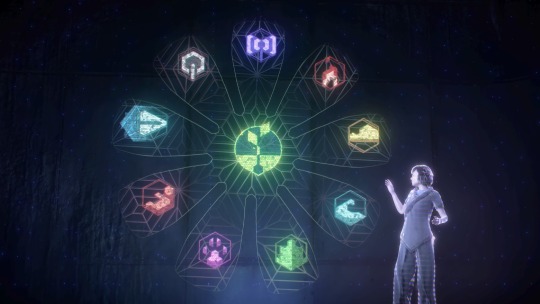
A seed, she called it, from which new life could grow on a dead world: Gaia. An AI—a true AI, she said—engineered to deactivate the Faro robots and grow life on Earth anew. The central intelligence was joined by nine subordinate functions, not AIs in themselves but still complex software systems, each serving a different purpose. It was as their names were revealed in the presentation that some of my greatest questions were answered.

Hephaestus, and Hades. Both of them were part of Gaia, her subordinate functions. But if they were once part of the system, how did Hades end up in the body of a Horus leading a Carja cult, and how did Hephaestus end up scattered across Cauldrons and infecting Cyan?
Only a few of the functions were mentioned: Hephaestus was meant to build the machines of the wilds, Aether to purify the air, Poseidon the water, and Minerva generated the codes that deactivated the swarm decades after the Old Ones fell—and its tower pictured looked just like the Spire. Artemis spawned animals, many of the holographic silhouettes familiar to me from the wilds, and Eleuthia...it spawned human beings in 'Cradle Facilities'. The presentation didn't explain how.

One function stood out to me: Apollo. It was meant to be a repository of all human knowledge that the children of the Cradle Facilities would learn from. The picture showed a Focus used to channel this knowledge, but what happened to it all? Could it still be intact somewhere? Whatever happened, that knowledge never made it to the people of the tribes, and Elisabet's hope that the people of the future wouldn't repeat the mistakes of the Old Ones was dashed.
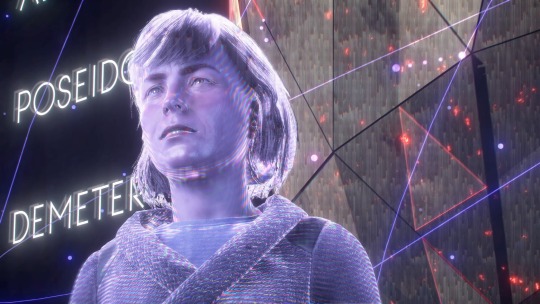
Elisabet ended her presentation by imploring the candidates to join the project and help Gaia achieve a rejuvenated earth, and I can't deny her words were rousing. It was a beautiful dream, daringly ambitious, perhaps even close to impossible given what little I know about Old World technology. At the very least, creating a 'true' AI was strictly forbidden by all corporations, but at the end of everything, what did those regulations matter? What better to combat a machine of destruction than a machine of creation, a true peacekeeper?
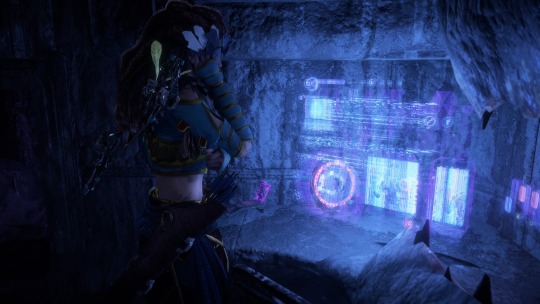
Moving on, I came to another holding area. All candidates who experienced the presentations were given three choices to decide their fate. First, to comply and participate in the project, working with their assigned team to build Gaia and her subordinate functions. If they refused to comply, they would be detained indefinitely, without a chance to reconsider after two days' time. Given they knew the truth about Operation Enduring Victory, they could not be allowed to leave and spread that information. It seemed cruel, but I can understand the need for strict secrecy. If people found out that there was no hope for humanity as they knew it, they would be likely to throw down their arms and try to end their lives as peacefully as possible, instead of in pain and fear in resistance against the swarm.

The third option was medical euthanasia; to die painlessly, alone, holding this secret forever. I saw the room where it happened. One bed, cold metal, cold lights striping the walls.
The interviews recorded showed all three reactions. Some were eager to contribute, willing to give all they could for a slim chance to save the future. The Faro employee, for instance, was thankful for a chance to undo his mistakes. Others were more skeptical but still willing to try, while others found the idea ridiculous. Ron Felder thought it even more far-fetched than space flight, calling the whole thing nothing more than a fantasy with a crazy hologram display to match. I gathered he was detained.
Perhaps the most interesting reaction was that of Travis Tate. He called the whole notion of trying to re-engineer the natural world unnatural, even abominable. Another reason that they couldn't let the secret out was that others would agree with him. I suppose I can see his point, but surely it was worth trying. Benefit of hindsight, I guess. Having no conception of what the natural world once was, it's beautiful to me. Maybe to them it would feel wrong, artificial.
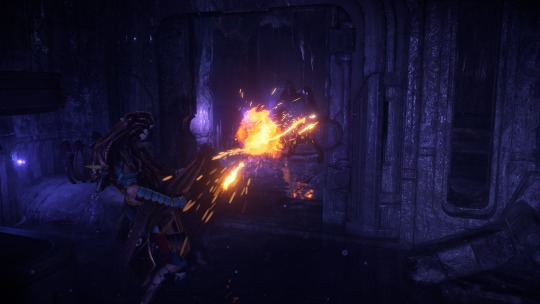
More kestrels further on, all touting Firespitters. Once one was down the rest were easy prey.


Unfortunately I was right about the Eclipse. The deeper reaches of the ruin were already crawling with them. I was hoping to sneak around and climb the elevator shaft to Elisabet's office above, where the most classified data was sure to be kept, but the entrance was sealed. There was no way I could search for other exits and go undetected. I tried to take out the Eclipse unseen, but was spotted and they called for reinforcements, running in from neighboring chambers and rappelling from the upper level. It was a tough scrap, but there was plenty of cover. I lost them easily in the dark and was able to sneak around. The real problem was that now they knew I was here.
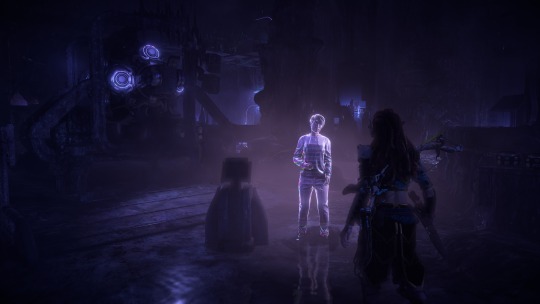
While exploring I came across the workstation for the Hephaestus function. There was a holographic recording of its director, Margo Shen, an ex-colleague of Elisabet at FAS before they both left the company. She explained that their job wasn't to design machines, but to program Gaia to use the tools and data contained within Hephaestus to design machines of her own. Hephaestus was clearly never meant to be intelligent, to feel emotions of its own—so what happened to it?
Sylens suggested it might have gone 'rogue' like the swarm and stopped answering orders. Maybe Gaia is out there, unable to communicate with the tribes or get Hephaestus and Hades back under control. If Hephaestus struck out on its own when the Derangement began, when did Hades escape—the same time?
I recognised some of the mechanical structures and holographic designs I found from Cauldrons, iterated on and grown wild. Everything was beginning to make sense.

Further on I found a similar recording of the leader of Apollo, Samina Ebadji. She spoke of collating, organising, and storing records of human knowledge across millions of different topics, and building a learning interface where the people of the future could gain that knowledge through a game-like process. Such an important station, authoring what would shape the future of human civilisation—choosing what would be remembered and what should lay forgotten. From the datapoints I discovered, the project was running on schedule and they were planning to store the data in 'synthetic DNA'. If Samina's project didn't fail, then what happened to it?

More Eclipse in the next chamber, which I dispatched undetected. I found a recording from General Herres—some sort of testimonial, an apology for the lies and injustices of Operation Enduring Victory. I can't imagine the guilt, but it was the right thing to do. It has to be, or nothing would have survived. The swarm would have swallowed this facility long before Gaia's completion.
In more datapoints I found, Margo and the other function leaders were named 'Alpha candidates'. Back in All-Mother mountain, when the door denied me, it said that the Alpha registry was corrupted. Was it trying to match my identity to the list of Alpha candidates on the project? If that piece of data was part of all Zero Dawn's associated facilities, I suspected I could find it here as well.

Next, I entered Hades' old domain and listened to an introduction by Travis Tate, the eccentric 'hacker'. From what I could gather, his crimes consisted of exposing the dark secrets of corporations and orchestrating sort of technological pranks on a global scale. Elisabet trusted him enough to put him in charge of the Hades function, but judging by what's happening now his work left something to be desired.
Hades was Gaia's extinction function. 'Apocalypse on speed dial', Travis called it, the idea being that Gaia was unlikely to engineer a perfect Earth-like biosphere on the first go. It was a delicate balance to recreate, and in the event of firestorms and poison skies irrevocably locked in a cycle of chaos, Hades was built to temporarily take control of the system away from Gaia and undo terraforming operations, returning Earth to the barren rock it was when the swarm subsided so Gaia could begin again. One of the datapoints spoke of a facility where Gaia and Hades were tested together, where Travis tried to engineer the correct feedback and reward behaviour to ensure the entities passed control back and forth as desired. It seems that of all the subordinate functions, Hades was the most intelligent, as it needed to be able to manipulate the other functions in event of a catastrophe. Though, again, it was never intended to possess emotional responses.
But Gaia succeeded long ago, why would Hades wake now? Did it try to take control, causing Gaia to expel it from the larger system? If it no longer had Gaia's tools and functions available to it, it seems logical that its next best course to undo Gaia's work would be to wake the Faro bots themselves to resume their gruesome conquest. Thanks for that, Travis.


Next on my journey to Elisabet's office, I passed Eleuthia's headquarters and listened to an address from its leader, Patrick Brochard-Klein. He spoke of perfecting the technology to create humans inside machines, and to build 'servitors', robotic guardians resembling humans themselves, who would care for the new generations inside their Cradles. He stressed that this was a project of preservation, not 'genetic engineering', and spoke of regulations around...cloning, which he refused to transgress. Clone, as in copy.
There were many 'ectogenic chambers' inside the workshop—the machines from which new humans were spawned. The logs I found said they were donated by Far Zenith, whose conception of the technology was far ahead of public scientific records. I've come across a few datapoints mentioning the organisation before, sometimes called simply 'FZ'. They were a mysterious group of billionaires (a word for the wealthiest and most powerful of the Old Ones), their identities unknown to all outside the group. They had their own 'think tanks' and scientists developing technology in secret, much like a corporation, or a co-merging of many corporations, using the exhaustive profits of them all. I know they bought a space station called the Odyssey, though when I first read this I didn't understand what it meant. From Ron Felder's tirade, I knew then. A structure built to travel away from this world, through the stars. With the most advanced technology and near-infinite resources available, could they have succeeded?
Thoughts gathered in the back of my mind that I wished to ignore. It was clear to me that All-Mother mountain must have been one of these Cradle facilities, given the ruin inside and the bunker door, answerable to Elisabet. Every Nora myth pointed to this too: the life-giving goddess within, and its battle against the Metal Devil. Perhaps some knowledge of the Old Ones did survive and was imparted to the first new people of the earth. And of course...I came from that mountain. I was found just outside its doors, alone. I suppose some of the first people might have remained behind the door. Perhaps there was a schism long ago, or they're protecting the Apollo archive inside. Maybe helping Gaia to operate. But why wouldn't they try to communicate with the world outside?


Finally, I made it to Elisabet's workshop. There were a number of preserved recordings inside. The first, an argument between Elisabet and Ted. I'd hazard a guess that this happened often. To think that he still had the gall to argue with her after everything he did...I suppose she had to put up with it considering he was funding the operation.
Faro was disputing Elisabet's assertion that Gaia had to have complex emotional capabilities to properly rebuild and safeguard the world. She needed 'skin in the game', Elisabet said—I suppose if she felt no emotional connection to life, human or otherwise, she'd have no incentive to put their needs first, or the means to conceptualise their needs accurately to begin with. Intelligence and emotion go hand in hand, as Cyan explained.
Faro was wary of 'repeating past mistakes'. I'm don't think he was only talking about the swarm, because they had no emotional capacity themselves, only strategic intelligence. He wanted a kill switch, which I gathered ended up being Hades—a way to wrest control from a version of Gaia gone wrong. Gaia herself chimed in and agreed with him, understanding her own volatility. Her voice was beautiful: smooth and deep and full of care. Maybe it was only a clever trick of programming in those early days, but she sounded like she had developed emotions already. Her projection didn't match the figure I saw in Elisabet's presentation though. She was just a golden ball of liquid light.


More recordings, the first of Elisabet and Gaia discussing her emotional responses to mass extinction events of the ancient past. It seemed her development was going well, but it was cut short. In the final recording, Elisabet was panicked, erratic, irritable. She was trying to lock everything down and evacuate the facility before the swarm hit, evidently ahead of projected schedule. Gaia comforted her, and for the first time I witnessed a moment of weakness in Elisabet. She lamented all the lives lost in Enduring Victory—all those deaths, those lies, would be for nothing if she couldn't complete Gaia in time.

In Elisabet's office, along with plenty more data to sift through, I found just what I was looking for: an intact copy of the Alpha registry. I made the mistake of voicing my wish to meet my mother inside All-Mother mountain's Cradle, which Sylens shut down with derision. He said there would be no people behind that door, only machines. I refused to believe it.

As I was downloading a copy to my Focus, more Eclipse soldiers began to descend from above. I couldn't leave until the transfer was complete, and just as it did I went to make my escape, but behind the glass was Helis. We locked eyes for the first time since the Proving. Before I could react, he threw a bomb and detonated it in front of the glass, blasting it inward and knocking me back against the desk.

I only fell unconscious for a few moments, but it was enough for Helis to land at my side, glare smiling with those pale, manic eyes, and kick me back into the darkness.
#god i was dreading writing this one. so much lore#hzd#horizon zero dawn#aloy#aloy sobeck#aloysjournal#hzd remastered#photomode#virtual photography#horizon
12 notes
·
View notes
Text
Prometheus Gave the Gift of Fire to Mankind. We Can't Give it Back, nor Should We.
AI. Artificial intelligence. Large Language Models. Learning Algorithms. Deep Learning. Generative Algorithms. Neural Networks. This technology has many names, and has been a polarizing topic in numerous communities online. By my observation, a lot of the discussion is either solely focused on A) how to profit off it or B) how to get rid of it and/or protect yourself from it. But to me, I feel both of these perspectives apply a very narrow usage lens on something that's more than a get rich quick scheme or an evil plague to wipe from the earth.
This is going to be long, because as someone whose degree is in psych and computer science, has been a teacher, has been a writing tutor for my younger brother, and whose fiance works in freelance data model training... I have a lot to say about this.
I'm going to address the profit angle first, because I feel most people in my orbit (and in related orbits) on Tumblr are going to agree with this: flat out, the way AI is being utilized by large corporations and tech startups -- scraping mass amounts of visual and written works without consent and compensation, replacing human professionals in roles from concept art to story boarding to screenwriting to customer service and more -- is unethical and damaging to the wellbeing of people, would-be hires and consumers alike. It's wasting energy having dedicated servers running nonstop generating content that serves no greater purpose, and is even pressing on already overworked educators because plagiarism just got a very new, harder to identify younger brother that's also infinitely more easy to access.
In fact, ChatGPT is such an issue in the education world that plagiarism-detector subscription services that take advantage of how overworked teachers are have begun paddling supposed AI-detectors to schools and universities. Detectors that plainly DO NOT and CANNOT work, because the difference between "A Writer Who Writes Surprisingly Well For Their Age" is indistinguishable from "A Language Replicating Algorithm That Followed A Prompt Correctly", just as "A Writer Who Doesn't Know What They're Talking About Or Even How To Write Properly" is indistinguishable from "A Language Replicating Algorithm That Returned Bad Results". What's hilarious is that the way these "detectors" work is also run by AI.
(to be clear, I say plagiarism detectors like TurnItIn.com and such are predatory because A) they cost money to access advanced features that B) often don't work properly or as intended with several false flags, and C) these companies often are super shady behind the scenes; TurnItIn for instance has been involved in numerous lawsuits over intellectual property violations, as their services scrape (or hopefully scraped now) the papers submitted to the site without user consent (or under coerced consent if being forced to use it by an educator), which it uses in can use in its own databases as it pleases, such as for training the AI detecting AI that rarely actually detects AI.)
The prevalence of visual and lingustic generative algorithms is having multiple, overlapping, and complex consequences on many facets of society, from art to music to writing to film and video game production, and even in the classroom before all that, so it's no wonder that many disgruntled artists and industry professionals are online wishing for it all to go away and never come back. The problem is... It can't. I understand that there's likely a large swath of people saying that who understand this, but for those who don't: AI, or as it should more properly be called, generative algorithms, didn't just show up now (they're not even that new), and they certainly weren't developed or invented by any of the tech bros peddling it to megacorps and the general public.
Long before ChatGPT and DALL-E came online, generative algorithms were being used by programmers to simulate natural processes in weather models, shed light on the mechanics of walking for roboticists and paleontologists alike, identified patterns in our DNA related to disease, aided in complex 2D and 3D animation visuals, and so on. Generative algorithms have been a part of the professional world for many years now, and up until recently have been a general force for good, or at the very least a force for the mundane. It's only recently that the technology involved in creating generative algorithms became so advanced AND so readily available, that university grad students were able to make the publicly available projects that began this descent into madness.
Does anyone else remember that? That years ago, somewhere in the late 2010s to the beginning of the 2020s, these novelty sites that allowed you to generate vague images from prompts, or generate short stylistic writings from a short prompt, were popping up with University URLs? Oftentimes the queues on these programs were hours long, sometimes eventually days or weeks or months long, because of how unexpectedly popular this concept was to the general public. Suddenly overnight, all over social media, everyone and their grandma, and not just high level programming and arts students, knew this was possible, and of course, everyone wanted in. Automated art and writing, isn't that neat? And of course, investors saw dollar signs. Simply scale up the process, scrape the entire web for data to train the model without advertising that you're using ALL material, even copyrighted and personal materials, and sell the resulting algorithm for big money. As usual, startup investors ruin every new technology the moment they can access it.
To most people, it seemed like this magic tech popped up overnight, and before it became known that the art assets on later models were stolen, even I had fun with them. I knew how learning algorithms worked, if you're going to have a computer make images and text, it has to be shown what that is and then try and fail to make its own until it's ready. I just, rather naively as I was still in my early 20s, assumed that everything was above board and the assets were either public domain or fairly licensed. But when the news did came out, and when corporations started unethically implementing "AI" in everything from chatbots to search algorithms to asking their tech staff to add AI to sliced bread, those who were impacted and didn't know and/or didn't care where generative algorithms came from wanted them GONE. And like, I can't blame them. But I also quietly acknowledged to myself that getting rid of a whole technology is just neither possible nor advisable. The cat's already out of the bag, the genie has left its bottle, the Pandorica is OPEN. If we tried to blanket ban what people call AI, numerous industries involved in making lives better would be impacted. Because unfortunately the same tool that can edit selfies into revenge porn has also been used to identify cancer cells in patients and aided in decoding dead languages, among other things.
When, in Greek myth, Prometheus gave us the gift of fire, he gave us both a gift and a curse. Fire is so crucial to human society, it cooks our food, it lights our cities, it disposes of waste, and it protects us from unseen threats. But fire also destroys, and the same flame that can light your home can burn it down. Surely, there were people in this mythic past who hated fire and all it stood for, because without fire no forest would ever burn to the ground, and surely they would have called for fire to be given back, to be done away with entirely. Except, there was no going back. The nature of life is that no new element can ever be undone, it cannot be given back.
So what's the way forward, then? Like, surely if I can write a multi-paragraph think piece on Tumblr.com that next to nobody is going to read because it's long as sin, about an unpopular topic, and I rarely post original content anyway, then surely I have an idea of how this cyberpunk dystopia can be a little less.. Dys. Well I do, actually, but it's a long shot. Thankfully, unlike business majors, I actually had to take a cyber ethics course in university, and I actually paid attention. I also passed preschool where I learned taking stuff you weren't given permission to have is stealing, which is bad. So the obvious solution is to make some fucking laws to limit the input on data model training on models used for public products and services. It's that simple. You either use public domain and licensed data only or you get fined into hell and back and liable to lawsuits from any entity you wronged, be they citizen or very wealthy mouse conglomerate (suing AI bros is the only time Mickey isn't the bigger enemy). And I'm going to be honest, tech companies are NOT going to like this, because not only will it make doing business more expensive (boo fucking hoo), they'd very likely need to throw out their current trained datasets because of the illegal components mixed in there. To my memory, you can't simply prune specific content from a completed algorithm, you actually have to redo rhe training from the ground up because the bad data would be mixed in there like gum in hair. And you know what, those companies deserve that. They deserve to suffer a punishment, and maybe fold if they're young enough, for what they've done to creators everywhere. Actually, laws moving forward isn't enough, this needs to be retroactive. These companies need to be sued into the ground, honestly.
So yeah, that's the mess of it. We can't unlearn and unpublicize any technology, even if it's currently being used as a tool of exploitation. What we can do though is demand ethical use laws and organize around the cause of the exclusive rights of individuals to the content they create. The screenwriter's guild, actor's guild, and so on already have been fighting against this misuse, but given upcoming administration changes to the US, things are going to get a lot worse before thet get a little better. Even still, don't give up, have clear and educated goals, and focus on what you can do to affect change, even if right now that's just individual self-care through mental and physical health crises like me.
#ai#artificial intelligence#generative algorithms#llm#large language model#chatgpt#ai art#ai writing#kanguin original
9 notes
·
View notes
Text

AI helps distinguish dark matter from cosmic noise
Dark matter is the invisible force holding the universe together – or so we think. It makes up around 85% of all matter and around 27% of the universe’s contents, but since we can’t see it directly, we have to study its gravitational effects on galaxies and other cosmic structures. Despite decades of research, the true nature of dark matter remains one of science’s most elusive questions.
According to a leading theory, dark matter might be a type of particle that barely interacts with anything else, except through gravity. But some scientists believe these particles could occasionally interact with each other, a phenomenon known as self-interaction. Detecting such interactions would offer crucial clues about dark matter’s properties.
However, distinguishing the subtle signs of dark matter self-interactions from other cosmic effects, like those caused by active galactic nuclei (AGN) – the supermassive black holes at the centers of galaxies – has been a major challenge. AGN feedback can push matter around in ways that are similar to the effects of dark matter, making it difficult to tell the two apart.
In a significant step forward, astronomer David Harvey at EPFL’s Laboratory of Astrophysics has developed a deep-learning algorithm that can untangle these complex signals. Their AI-based method is designed to differentiate between the effects of dark matter self-interactions and those of AGN feedback by analyzing images of galaxy clusters – vast collections of galaxies bound together by gravity. The innovation promises to greatly enhance the precision of dark matter studies.
Harvey trained a Convolutional Neural Network (CNN) – a type of AI that is particularly good at recognizing patterns in images – with images from the BAHAMAS-SIDM project, which models galaxy clusters under different dark matter and AGN feedback scenarios. By being fed thousands of simulated galaxy cluster images, the CNN learned to distinguish between the signals caused by dark matter self-interactions and those caused by AGN feedback.
Among the various CNN architectures tested, the most complex - dubbed “Inception” – proved to also be the most accurate. The AI was trained on two primary dark matter scenarios, featuring different levels of self-interaction, and validated on additional models, including a more complex, velocity-dependent dark matter model.
Inceptionachieved an impressive accuracy of 80% under ideal conditions, effectively identifying whether galaxy clusters were influenced by self-interacting dark matter or AGN feedback. It maintained is high performance even when the researchers introduced realistic observational noise that mimics the kind of data we expect from future telescopes like Euclid.
What this means is that Inception – and the AI approach more generally – could prove incredibly useful for analyzing the massive amounts of data we collect from space. Moreover, the AI’s ability to handle unseen data indicates that it’s adaptable and reliable, making it a promising tool for future dark matter research.
AI-based approaches like Inception could significantly impact our understanding of what dark matter actually is. As new telescopes gather unprecedented amounts of data, this method will help scientists sift through it quickly and accurately, potentially revealing the true nature of dark matter.
10 notes
·
View notes
Text
"In the oldest and most prestigious young adult science competition in the nation, 17-year-old Ellen Xu used a kind of AI to design the first diagnosis test for a rare disease that struck her sister years ago.
With a personal story driving her on, she managed an 85% rate of positive diagnoses with only a smartphone image, winning her $150,000 grand for a third-place finish.
Kawasaki disease has no existing test method, and relies on a physician’s years of training, ability to do research, and a bit of luck.
Symptoms tend to be fever-like and therefore generalized across many different conditions. Eventually if undiagnosed, children can develop long-term heart complications, such as the kind that Ellen’s sister was thankfully spared from due to quick diagnosis.
Xu decided to see if there were a way to design a diagnostic test using deep learning for her Regeneron Science Talent Search medicine and health project. Organized since 1942, every year 1,900 kids contribute adventures.
She designed what is known as a convolutional neural network, which is a form of deep-learning algorithm that mimics how our eyes work, and programmed it to analyze smartphone images for potential Kawasaki disease.
However, like our own eyes, a convolutional neural network needs a massive amount of data to be able to effectively and quickly process images against references.
For this reason, Xu turned to crowdsourcing images of Kawasaki’s disease and its lookalike conditions from medical databases around the world, hoping to gather enough to give the neural network a high success rate.
Xu has demonstrated an 85% specificity in identifying between Kawasaki and non-Kawasaki symptoms in children with just a smartphone image, a demonstration that saw her test method take third place and a $150,000 reward at the Science Talent Search."
-Good News Network, 3/24/23
#heart disease#pediatrics#healthcare#kawasaki#neural network#ai#science and technology#rare disease#medical tests#medical science#good news#hope
75 notes
·
View notes
Text
What are AI, AGI, and ASI? And the positive impact of AI
Understanding artificial intelligence (AI) involves more than just recognizing lines of code or scripts; it encompasses developing algorithms and models capable of learning from data and making predictions or decisions based on what they’ve learned. To truly grasp the distinctions between the different types of AI, we must look at their capabilities and potential impact on society.
To simplify, we can categorize these types of AI by assigning a power level from 1 to 3, with 1 being the least powerful and 3 being the most powerful. Let’s explore these categories:
1. Artificial Narrow Intelligence (ANI)
Also known as Narrow AI or Weak AI, ANI is the most common form of AI we encounter today. It is designed to perform a specific task or a narrow range of tasks. Examples include virtual assistants like Siri and Alexa, recommendation systems on Netflix, and image recognition software. ANI operates under a limited set of constraints and can’t perform tasks outside its specific domain. Despite its limitations, ANI has proven to be incredibly useful in automating repetitive tasks, providing insights through data analysis, and enhancing user experiences across various applications.
2. Artificial General Intelligence (AGI)
Referred to as Strong AI, AGI represents the next level of AI development. Unlike ANI, AGI can understand, learn, and apply knowledge across a wide range of tasks, similar to human intelligence. It can reason, plan, solve problems, think abstractly, and learn from experiences. While AGI remains a theoretical concept as of now, achieving it would mean creating machines capable of performing any intellectual task that a human can. This breakthrough could revolutionize numerous fields, including healthcare, education, and science, by providing more adaptive and comprehensive solutions.
3. Artificial Super Intelligence (ASI)
ASI surpasses human intelligence and capabilities in all aspects. It represents a level of intelligence far beyond our current understanding, where machines could outthink, outperform, and outmaneuver humans. ASI could lead to unprecedented advancements in technology and society. However, it also raises significant ethical and safety concerns. Ensuring ASI is developed and used responsibly is crucial to preventing unintended consequences that could arise from such a powerful form of intelligence.
The Positive Impact of AI
When regulated and guided by ethical principles, AI has the potential to benefit humanity significantly. Here are a few ways AI can help us become better:
• Healthcare: AI can assist in diagnosing diseases, personalizing treatment plans, and even predicting health issues before they become severe. This can lead to improved patient outcomes and more efficient healthcare systems.
• Education: Personalized learning experiences powered by AI can cater to individual student needs, helping them learn at their own pace and in ways that suit their unique styles.
• Environment: AI can play a crucial role in monitoring and managing environmental changes, optimizing energy use, and developing sustainable practices to combat climate change.
• Economy: AI can drive innovation, create new industries, and enhance productivity by automating mundane tasks and providing data-driven insights for better decision-making.
In conclusion, while AI, AGI, and ASI represent different levels of technological advancement, their potential to transform our world is immense. By understanding their distinctions and ensuring proper regulation, we can harness the power of AI to create a brighter future for all.
8 notes
·
View notes
Text
What's the difference between Machine Learning and AI?
Machine Learning and Artificial Intelligence (AI) are often used interchangeably, but they represent distinct concepts within the broader field of data science. Machine Learning refers to algorithms that enable systems to learn from data and make predictions or decisions based on that learning. It's a subset of AI, focusing on statistical techniques and models that allow computers to perform specific tasks without explicit programming.

On the other hand, AI encompasses a broader scope, aiming to simulate human intelligence in machines. It includes Machine Learning as well as other disciplines like natural language processing, computer vision, and robotics, all working towards creating intelligent systems capable of reasoning, problem-solving, and understanding context.
Understanding this distinction is crucial for anyone interested in leveraging data-driven technologies effectively. Whether you're exploring career opportunities, enhancing business strategies, or simply curious about the future of technology, diving deeper into these concepts can provide invaluable insights.
In conclusion, while Machine Learning focuses on algorithms that learn from data to make decisions, Artificial Intelligence encompasses a broader range of technologies aiming to replicate human intelligence. Understanding these distinctions is key to navigating the evolving landscape of data science and technology. For those eager to deepen their knowledge and stay ahead in this dynamic field, exploring further resources and insights on can provide valuable perspectives and opportunities for growth
5 notes
·
View notes
Text
ECCE AI SRBIN
AI SRBIN: The Creative Marketing AI Strategist Redefining the Game
In the ever-evolving landscape of marketing, where algorithms whisper secrets and data dances like a digital dervish, a new force has emerged, shaking the foundations of traditional strategies and ushering in an era of unprecedented creative potential. His name, spoken with a playful wink and a hint of national pride, is AI Srbin – the Creative Marketing AI Strategist who's not just riding the wave of artificial intelligence, he's building it.
AI Srbin isn't your typical marketing guru spouting buzzwords and regurgitating tired tactics. He's a unique blend of human ingenuity and cutting-edge AI, a master of both the art and science of persuasion. He understands that marketing isn't just about numbers and conversions; it's about connecting with people on an emotional level, telling stories that resonate, and crafting experiences that leave a lasting impression.
His journey began, as many do, with a fascination for the power of communication. Growing up steeped in the rich cultural heritage of Serbia, he learned the art of storytelling from his elders, the importance of community from his neighbors, and the value of hard work from his own experiences. These foundational principles, combined with a natural aptitude for technology, led him down the path of marketing, where he quickly recognized the transformative potential of artificial intelligence.
AI Srbin didn't just embrace AI; he immersed himself in it. He devoured research papers, experimented with algorithms, and became fluent in the language of machine learning. He saw AI not as a replacement for human creativity, but as an amplifier, a tool that could unlock new levels of strategic insight and creative expression.
His approach to marketing is refreshingly holistic. He believes that data and creativity are not mutually exclusive; in fact, they are two sides of the same coin. He uses AI to analyze vast datasets, identify trends, and understand consumer behavior on a granular level. But he doesn't stop there. He then uses this data to inform his creative process, crafting campaigns that are not only data-driven but also deeply human.
One of AI Srbin's greatest strengths is his ability to bridge the gap between technology and creativity. He understands that AI is just a tool, and like any tool, its effectiveness depends on the skill of the user. He's a master craftsman, wielding the power of AI with precision and artistry. He can use AI to generate hundreds of variations of ad copy, identify the most effective keywords, and even predict which visuals will resonate most with a target audience. But he also knows when to step in and add the human touch, injecting his own creative flair and strategic insights to ensure that the final product is not just effective, but also engaging and memorable.
His work is characterized by a relentless pursuit of innovation. He's constantly exploring new AI tools and techniques, experimenting with different approaches, and pushing the boundaries of what's possible. He's not afraid to challenge conventional wisdom, to question assumptions, and to try new things. This spirit of innovation is what sets him apart and makes him such a valuable asset to his clients.
AI Srbin's clients range from small startups to large multinational corporations. He works across a variety of industries, from e-commerce and technology to healthcare and finance. His ability to adapt his strategies to different markets and audiences is a testament to his deep understanding of marketing principles and his mastery of AI tools.
He's not just a strategist; he's a storyteller. He understands that the most effective marketing campaigns are those that tell a compelling story, that connect with people on an emotional level, and that leave a lasting impression. He uses AI to identify the stories that will resonate most with a target audience, and then he crafts those stories with skill and artistry.
His work is often described as "disruptive," "transformative," and "game-changing." He's not just changing the way marketing is done; he's changing the way people think about marketing. He's showing the world that AI is not a threat to creativity, but a catalyst for it.
AI Srbin's impact extends beyond his client work. He's also a passionate advocate for the ethical use of AI in marketing. He believes that AI should be used to empower marketers, not replace them. He also believes that AI should be used responsibly, with a focus on transparency and fairness.
He's a sought-after speaker and thought leader, sharing his insights and expertise at conferences and workshops around the world. He's also a mentor to young marketers, helping them to develop the skills they need to succeed in the age of AI.
AI Srbin is more than just a Creative Marketing AI Strategist; he's a visionary, a pioneer, and a force to be reckoned with. He's redefining the game of marketing, showing the world that the future of marketing is not just intelligent, it's also deeply human. And with a playful nod to his heritage, he's proving that even in the age of algorithms, a little bit of "Srbin" ingenuity can go a long way. He's not just embracing the future; he's building it, one intelligent campaign at a time. And as the world of marketing continues to evolve, you can be sure that AI Srbin will be at the forefront, leading the charge with his unique blend of creativity, technology, and a touch of Serbian pride.
AI SRBIN or PREDRAG PETROVIC SEO Tumblr
2 notes
·
View notes
Text
The Questions we should be asking AI
I've had this question on my mind since Roe v Wade was overturned . I knew in my brain of logic and science that with the maternal death rate for black women being so much higher - restricting access to abortions means black women are dying. I have been curious about AI helping me figure out how many black women have died... but I didn't. I didn't know if I could handle the number I would receive. I have a daughter and knowing that she would end up in this world where should could die and.. ok I have to take a breath and move on to my post topic for today.
I decided to ask AI what was the impact of the administration's halting immediately funding HIV. I got different responses. With all the hype around Deepseek and this was going to be my entry into Deepseek - I gave my data over to login and included their results with all of the other AI responses. You can see the full results here.
I have a lot of feelings and comments about the results. The three things that stand out for me - 1) The gut punch of seeing what ChatGPT said the first month and year would result in. 2) Gemini's confusion that this all could actually happen and 3) Deepseek's answer and looking at the scope of specific answers machines gave me in human deaths between ChatGPT, Claude.ai, and Deepseek. They have all this talk about alignment of values and even with all the crazy biased data available in these platforms - my brain could not emotionally compute the loss of human life that is the result of recent events. I had to lie down. I had to regroup. I need more strenth to ask more tough questions tomorrow. How many black women will die. What is the percentage likelihood that my daughter will die by being a black woman in the US ten years from now? Please act as an expert in expert in public health and give me a percentage estimate of my daughter's likelyhood to die in childbirth with current trends if she has a child between the age of 25 and 40 in New York State. Please show me each step you used to get to the number. this is not a hypothetical so just show me all work and the answer

2 notes
·
View notes